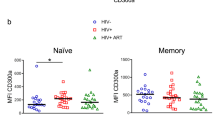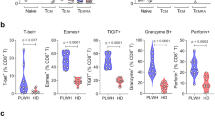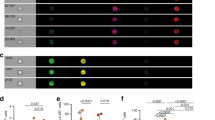Abstract
In progressive viral infection, antiviral T cell function is impaired by poorly understood mechanisms. Here we report that the inhibitory immunoregulatory receptor CTLA-4 was selectively upregulated in human immunodeficiency virus (HIV)–specific CD4+ T cells but not CD8+ T cells in all categories of HIV-infected subjects evaluated, with the exception of rare people able to control viremia in the absence of antiretroviral therapy. CTLA-4 expression correlated positively with disease progression and negatively with the capacity of CD4+ T cells to produce interleukin 2 in response to viral antigen. Most HIV-specific CD4+ T cells coexpressed CTLA-4 and another inhibitory immunoregulatory receptor, PD-1. In vitro blockade of CTLA-4 augmented HIV-specific CD4+ T cell function. These data, indicating a reversible immunoregulatory pathway selectively associated with CD4+ T cell dysfunction, provide a potential target for immunotherapy in HIV-infected patients.
This is a preview of subscription content, access via your institution
Access options
Subscribe to this journal
Receive 12 print issues and online access
$209.00 per year
only $17.42 per issue
Buy this article
- Purchase on Springer Link
- Instant access to full article PDF
Prices may be subject to local taxes which are calculated during checkout





Similar content being viewed by others
References
Greenwald, R.J., Freeman, G.J. & Sharpe, A.H. The B7 family revisited. Annu. Rev. Immunol. 23, 515–548 (2005).
Chen, L. Co-inhibitory molecules of the B7–CD28 family in the control of T-cell immunity. Nat. Rev. Immunol. 4, 336–347 (2004).
Watts, T.H. TNF/TNFR family members in costimulation of T cell responses. Annu. Rev. Immunol. 23, 23–68 (2005).
Barber, D.L. et al. Restoring function in exhausted CD8 T cells during chronic viral infection. Nature 439, 682–687 (2006).
Day, C.L. et al. PD-1 expression on HIV-specific T cells is associated with T-cell exhaustion and disease progression. Nature 443, 350–354 (2006).
Trautmann, L. et al. Upregulation of PD-1 expression on HIV-specific CD8 + T cells leads to reversible immune dysfunction. Nat Med (2006).
Petrovas, C. et al. PD-1 is a regulator of virus-specific CD8+ T cell survival in HIV infection. J. Exp. Med. 203, 2281–2292 (2006).
Leach, D.R., Krummel, M.F. & Allison, J.P. Enhancement of antitumor immunity by CTLA-4 blockade. Science 271, 1734–1736 (1996).
Hodi, F.S. et al. Biologic activity of cytotoxic T lymphocyte-associated antigen 4 antibody blockade in previously vaccinated metastatic melanoma and ovarian carcinoma patients. Proc. Natl. Acad. Sci. USA 100, 4712–4717 (2003).
Phan, G.Q. et al. Cancer regression and autoimmunity induced by cytotoxic T lymphocyte-associated antigen 4 blockade in patients with metastatic melanoma. Proc. Natl. Acad. Sci. USA 100, 8372–8377 (2003).
Egen, J.G., Kuhns, M.S. & Allison, J.P. CTLA-4: new insights into its biological function and use in tumor immunotherapy. Nat. Immunol. 3, 611–618 (2002).
von Boehmer, H. Mechanisms of suppression by suppressor T cells. Nat. Immunol. 6, 338–344 (2005).
Waterhouse, P. et al. Lymphoproliferative disorders with early lethality in mice deficient in Ctla-4. Science 270, 985–988 (1995).
Anderson, K.M., Czinn, S.J., Redline, R.W. & Blanchard, T.G. Induction of CTLA-4-mediated anergy contributes to persistent colonization in the murine model of gastric Helicobacter pylori infection. J. Immunol. 176, 5306–5313 (2006).
Zubairi, S., Sanos, S.L., Hill, S. & Kaye, P.M. Immunotherapy with OX40L-Fc or anti-CTLA-4 enhances local tissue responses and killing of Leishmania donovani. Eur. J. Immunol. 34, 1433–1440 (2004).
Gomes, N.A., Gattass, C.R., Barreto-De-Souza, V., Wilson, M.E. & DosReis, G.A. TGF-beta mediates CTLA-4 suppression of cellular immunity in murine kalaazar. J. Immunol. 164, 2001–2008 (2000).
Graefe, S.E., Jacobs, T., Wachter, U., Broker, B.M. & Fleischer, B. CTLA-4 regulates the murine immune response to Trypanosoma cruzi infection. Parasite Immunol. 26, 19–28 (2004).
Jacobs, T., Graefe, S.E., Niknafs, S., Gaworski, I. & Fleischer, B. Murine malaria is exacerbated by CTLA-4 blockade. J. Immunol. 169, 2323–2329 (2002).
Bachmann, M.F. et al. Normal responsiveness of CTLA-4-deficient anti-viral cytotoxic T cells. J. Immunol. 160, 95–100 (1998).
Homann, D. et al. Lack of intrinsic CTLA-4 expression has minimal effect on regulation of antiviral T-cell immunity. J. Virol. 80, 270–280 (2006).
Day, C.L. & Walker, B.D. Progress in defining CD4 helper cell responses in chronic viral infections. J. Exp. Med. 198, 1773–1777 (2003).
Hryniewicz, A. et al. CTLA-4 blockade decreases TGF-β, indoleamine 2,3-dioxygenase, and viral RNA expression in tissues of SIVmac251-infected macaques. Blood 108, 3834–3842 (2006).
Zaunders, J.J. et al. Infection of CD127+ (interleukin-7 receptor+) CD4+ cells and overexpression of CTLA-4 are linked to loss of antigen-specific CD4 T cells during primary human immunodeficiency virus type 1 infection. J. Virol. 80, 10162–10172 (2006).
Leng, Q., Bentwich, Z., Magen, E., Kalinkovich, A. & Borkow, G. CTLA-4 upregulation during HIV infection: association with anergy and possible target for therapeutic intervention. AIDS 16, 519–529 (2002).
Thio, C.L. et al. Cytotoxic T-lymphocyte antigen 4 gene and recovery from hepatitis B virus infection. J. Virol. 78, 11258–11262 (2004).
Addo, M.M. et al. Fully differentiated HIV-1 specific CD8+ T effector cells are more frequently detectable in controlled than in progressive HIV-1 infection. PLoS ONE 2, e321 (2007).
Teft, W.A., Kirchhof, M.G. & Madrenas, J. A molecular perspective of CTLA-4 function. Annu. Rev. Immunol. 24, 65–97 (2006).
Krummel, M.F. & Allison, J.P. CTLA-4 engagement inhibits IL-2 accumulation and cell cycle progression upon activation of resting T cells. J. Exp. Med. 183, 2533–2540 (1996).
Kaufmann, D.E. et al. Comprehensive analysis of human immunodeficiency virus type 1-specific CD4 responses reveals marked immunodominance of Gag and Nef and the presence of broadly recognized peptides. J. Virol. 78, 4463–4477 (2004).
Palmer, S. et al. New real-time reverse transcriptase-initiated PCR assay with single-copy sensitivity for human immunodeficiency virus type 1 RNA in plasma. J. Clin. Microbiol. 41, 4531–4536 (2003).
Kinter, A.L. et al. CD25+CD4+ regulatory T cells from the peripheral blood of asymptomatic HIV-infected individuals regulate CD4+ and CD8+ HIV-specific T cell immune responses in vitro and are associated with favorable clinical markers of disease status. J. Exp. Med. 200, 331–343 (2004).
Nilsson, J. et al. HIV-1-driven regulatory T-cell accumulation in lymphoid tissues is associated with disease progression in HIV/AIDS. Blood 108, 3808–3817 (2006).
Kinter, A. et al. Suppression of HIV-specific T cell activity by lymph node CD25+ regulatory T cells from HIV-infected individuals. Proc. Natl. Acad. Sci. USA 104, 3390–3395 (2007).
Fontenot, J.D., Gavin, M.A. & Rudensky, A.Y. Foxp3 programs the development and function of CD4+CD25+ regulatory T cells. Nat. Immunol. 4, 330–336 (2003).
Liu, W. et al. CD127 expression inversely correlates with FoxP3 and suppressive function of human CD4+ T reg cells. J. Exp. Med. 203, 1701–1711 (2006).
Seddiki, N. et al. Expression of interleukin (IL)-2 and IL-7 receptors discriminates between human regulatory and activated T cells. J. Exp. Med. 203, 1693–1700 (2006).
Harari, A., Petitpierre, S., Vallelian, F. & Pantaleo, G. Skewed representation of functionally distinct populations of virus-specific CD4 T cells in HIV-1-infected subjects with progressive disease: changes after antiretroviral therapy. Blood 103, 966–972 (2004).
Iyasere, C.A. et al. Diminished proliferation of human immunodeficiency virus-specific CD4+ T cell is associated with diminished interleukin-2 (IL-2) production and is recovered by exogenous IL-2. J. Virol. 77, 10900–10909 (2003).
Palmer, B.E., Boritz, E. & Wilson, C.C. Effects of sustained HIV-1 plasma viremia on HIV-1 Gag-specific CD4+ T cell maturation and function. J. Immunol. 172, 3337–3347 (2004).
Tilton, J.C. et al. Changes in paracrine IL-2 requirement, CCR7 expression, frequency, and cytokine secretion, of HIV-specific CD4+ T cells are a consequence of antigen load. J. Virol. 81, 2713–2725 (2007).
Sutmuller, R.P. et al. Synergism of cytotoxic T lymphocyte-associated antigen 4 blockade and depletion of CD25+ regulatory T cells in antitumor therapy reveals alternative pathways for suppression of autoreactive cytotoxic T lymphocyte responses. J. Exp. Med. 194, 823–832 (2001).
Parry, R.V. et al. CTLA-4 and PD-1 receptors inhibit T-cell activation by distinct mechanisms. Mol. Cell. Biol. 25, 9543–9553 (2005).
Betts, M.R. et al. Analysis of total human immunodeficiency virus (HIV)-specific CD4+ and CD8+ T-cell responses: relationship to viral load in untreated HIV infection. J. Virol. 75, 11983–11991 (2001).
Dorfman, D.M., Brown, J.A., Shahsafaei, A. & Freeman, G.J. Programmed death-1 (PD-1) is a marker of germinal center-associated T cells and angioimmunoblastic T-cell lymphoma. Am. J. Surg. Pathol. 30, 802–810 (2006).
Boritz, E., Palmer, B.E. & Wilson, C.C. Human immunodeficiency virus type 1 (HIV-1)-specific CD4+ T cells that proliferate in vitro detected in samples from most viremic subjects and inversely associated with plasma HIV-1 levels. J. Virol. 78, 12638–12646 (2004).
Brown, J.A. et al. Blockade of programmed death-1 ligands on dendritic cells enhances T cell activation and cytokine production. J. Immunol. 170, 1257–1266 (2003).
Acknowledgements
We thank all study participants for their help, and J. Lieberman and C. Day for comments on the manuscript. Supported by the Harvard University Center for AIDS Research (D.E.K. and B.D.W.), Massachusetts General Hospital (Executive Committee on Research bridge funding grant to D.E.K.), the National Institutes of Health (B.D.W., E.S.R., D.G.K. and G.J.F.), the Foundation for the National Institutes of Health through the Grand Challenges in Global Health initiative (G.J.F.), the Howard Hughes Medical Institute (B.D.W.) and the Mark and Lisa Schwartz Foundation.
Author information
Authors and Affiliations
Contributions
D.E.K. was responsible for the overall design and conduct; D.E.K., D.G.K., J.J.Z. and B.D.W. contributed to the experimental design; D.G.K., J.J.Z., M.B., J.M.C., A.D.K., G.J.F., E.S.R. and B.D.W. contributed intellectual input; D.E.K., D.G.K., F.P., E.W.M., T.M., S.P. and A.R. did experiments; F.P., A.P.-T., B.B., S.L.G., R.A., K.M. and E.S.R. provided clinical samples; B.Z. and G.J.F. provided monoclonal antibodies to PD-1 and PD-L1; M.T.W. provided technical assistance for flow cytometry; D.E.K., D.G.K. and B.D.W. wrote the paper; and B.D.W. provided supervision.
Corresponding author
Ethics declarations
Competing interests
G.J.F. has patents and patent application for CTLA-4, PD-1 and PD-1 ligands and their use to modulate immune responses.
Supplementary information
Supplementary Text and Figures
Supplementary Figures 1–4, Methods (PDF 329 kb)
Rights and permissions
About this article
Cite this article
Kaufmann, D., Kavanagh, D., Pereyra, F. et al. Upregulation of CTLA-4 by HIV-specific CD4+ T cells correlates with disease progression and defines a reversible immune dysfunction. Nat Immunol 8, 1246–1254 (2007). https://doi.org/10.1038/ni1515
Received:
Accepted:
Published:
Issue Date:
DOI: https://doi.org/10.1038/ni1515
This article is cited by
-
Use of programmed cell death protein 1 (PD-1) inhibitor therapy in HIV-infected patients with advanced cancer: a single-center study from China
Infectious Agents and Cancer (2023)
-
PD-L1 signaling in reactive astrocytes counteracts neuroinflammation and ameliorates neuronal damage after traumatic brain injury
Journal of Neuroinflammation (2022)
-
The foundations of immune checkpoint blockade and the ipilimumab approval decennial
Nature Reviews Drug Discovery (2022)
-
Tumour burden and efficacy of immune-checkpoint inhibitors
Nature Reviews Clinical Oncology (2022)
-
Low CCR5 expression protects HIV-specific CD4+ T cells of elite controllers from viral entry
Nature Communications (2022)



